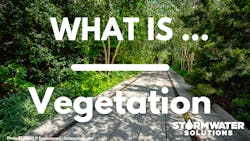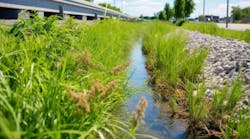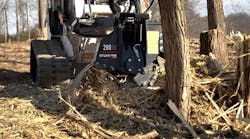In short, vegetation is plant life or plant cover.
When it comes to stormwater, vegetation is often discussed in terms of green infrastructure and in erosion control best practices. This article will explore vegetation types, uses and best practices.
Types of vegetation
According to the Department of Environmental Protection in Montgomery County, Maryland, some people manage vegetated facilities, meaning facilities that “use plants and soil to slow down, filter, and absorb stormwater runoff on your property after it rains.” Common vegetated facilities include: bioretentions, curb extensions, tree boxes, bioswales, rain gardens, vegetated filter strips, constructed wetlands and more. Bioretention and bioswales are two of the most common practices.
Biorientation areas “are shallow, landscaped depressions that allow runoff to pond in a designated area, then filter through soil and vegetation. Small-scale bioretention areas are also known as rain gardens,” according to the U.S. Environmental Protection Agency (EPA).
Swales, which can be vegetated, are drainage paths or channels used to transport water, EPA said.
They can be used in small drainage areas with low runoff instead of underground storm sewers or concrete open channels. Swales help slow runoff, facilitate infiltration and filter pollutants as runoff flows through the system,” the EPA website said.
When it comes to selecting which type of vegetation to use, consider the following for the designated area:
- Does frequent flooding occur near the site?
- Is roadway salt used nearby?
- Is the area prone to drought?
It should also be noted that if vegetation is going to be planted on a slope, the slope should be stabilized prior to planting to ensure there is no potential collapse.
Vegetation impacts
From runoff control to wildlife habitats, vegetation has various impacts on its surrounding environment.
According to Oklahoma State University, “Vegetation intercepts rain, reducing its energy and preventing splash erosion. It also slows runoff, reduces sheet erosion, and anchors and reinforces the soil with its root system.”
The university site also explained that vegetation “limits the capacity of flowing water to detach soil particles and transport sediment by decreasing runoff volume, slowing velocity, and protecting the soil surface from flowing water.”
The Pinellas County Public Works Department, which is responsible for stormwater and vegetation management, explains on its website that managing vegetation can help control invasive and nuisance weeds in stormwater, retention and mitigation ponds, lakes and ditches.
“Vegetation management also maintains county lakes and ponds according to permit guidelines, which act as retention, mitigation or filtration systems and county waterways (ditches, canals) for unobstructed stormwater drainage for watershed management,” the Pinellas County website said.
Vegetation & erosion control
It is hard to discuss vegetation without diving into its relationship with erosion control. While vegetation commonly goes together with green infrastructure, it has a similarly close relationship with erosion control.
A report by the Massachusetts Office of Coastal Zone Management, explored the relationship between storm damage and erosion.
“Plant roots hold sediment in place, helping to stabilize the areas where they are planted,” the report said. “Second, by absorbing water, breaking the impact of raindrops or wave-splash, and physically slowing the speed and diffusing the flow of overland runoff, plants reduce runoff erosion.”
The report continued by explaining that vegetation can “trap” windblown sand and increase dunes’ abilities to “buffer inland areas from storm waves, erosion and flooding.”
Conclusion
In conclusion, vegetation can be helpful in many practices when it comes to stormwater and erosion control management. With the proper research, including native plants and site and soil conditions, vegetation can provide water treatment and stabilization to many projects.







